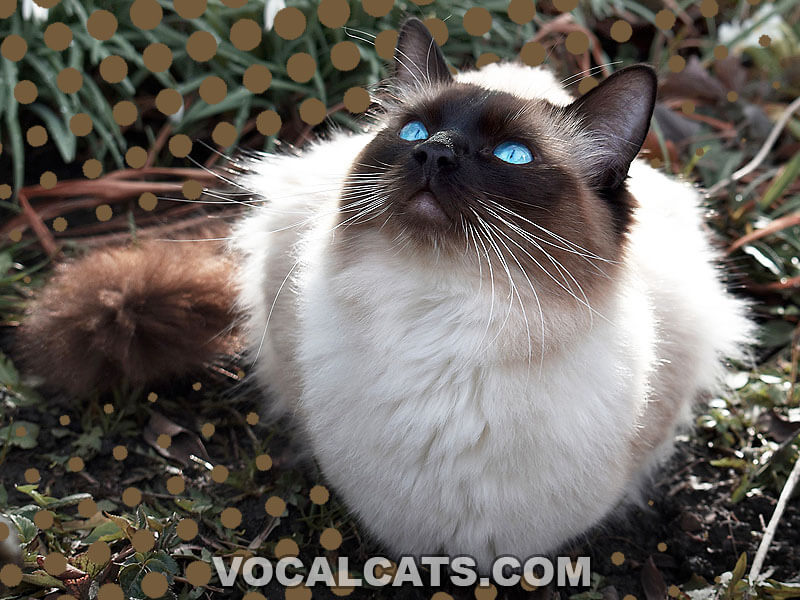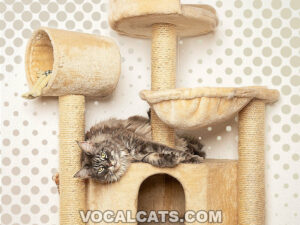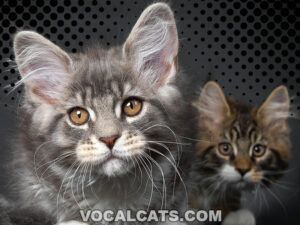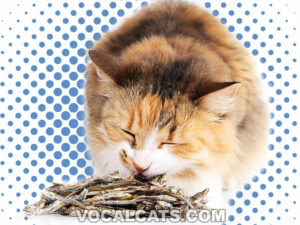Felines are available in various temperaments, colors, and sizes. But few are as popular as the Chocolate Point Ragdoll. These cats are famous for their coat appearance and gentle behavior.
If you’re a Chocolate Point Cat enthusiast in search of information, you’re at the right place. This comprehensive guide will highlight all there is to this breed – including their personality, food requirements, training, grooming, and exercise needs.
Sometimes called Brown Ragdoll Cat, we’ll also go over their physical appearance, genetics, and various Chocolate Pointed Ragdoll colors. If you’re still interested in the Chocolate Ragdoll Cat after reading this, we’ve included a list of breeders you can reach out to. So go ahead and scroll down to discover more!
RECOMMENDED: Himalayan Ragdoll Cat (Complete Guide)
Contents
- Chocolate Pointed Ragdoll: Breed overview
- What is a Chocolate Point Ragdoll? What does “Chocolate Point” mean in Ragdolls?
- Chocolate Ragdoll physical appearance
- Chocolate Point Ragdoll genetics
- Is a Chocolate Point Ragdoll rare?
- Are Chocolate Ragdolls born brown?
- Do all Chocolate Ragdolls have blue eyes?
- Is Chocolate a recognized Ragdoll Cat color?
- Various Chocolate Pointed Ragdoll colors and patterns
- Can Chocolate Ragdolls change color?
- Do Chocolate Ragdolls change color when their body temperature is high?
- Do Chocolate Ragdolls change color when their body temperature is low?
- Do Chocolate Ragdolls get darker coats when they get older?
- Chocolate Ragdoll Cat size, height, and weight
- Are overweight Chocolate Ragdolls darker in color than slim Chocolate Ragdolls?
- Chocolate Ragdoll Cats personality and temperament
- Chocolate Point Ragdoll Cat training
- Ragdoll Chocolate Point exercise requirement
- Chocolate Point Ragdoll Cats grooming and cleaning
- Do Chocolate Point Ragdolls shed a lot?
- Are Chocolate Ragdoll Cats hypoallergenic?
- Chocolate Point Ragdoll food and diet
- Chocolate Pointed Ragdoll health issues
- Chocolate Ragdoll lifespan
- Chocolate Ragdoll Cat breeders
- Chocolate Ragdoll kittens
- Chocolate Point Ragdoll price
- Places to find Chocolate Ragdoll kittens for sale
- Finding a healthy Chocolate Point Ragdoll for sale
- Chocolate Point Ragdoll: Pros and Cons
- Is the Chocolate Pointed Ragdoll right for me?
- Related Questions
Chocolate Pointed Ragdoll: Breed overview
Don’t have a lot of time to read about Chocolate Point Ragdolls? No problem. This brief overview section can give you some pertinent facts.
| Other Names | Brown Ragdoll, Chocolate Point |
| Size | Large |
| Weight | 15-20 pounds |
| Height | 9-11 inches |
| Lifespan | Up to 15 years |
| Coat Colors | Chocolate brown, ivory, or cream |
| Child Friendliness | High |
| Feline Friendliness | High |
| Training Difficulty | Low to Medium |
| Grooming Upkeep | Low |
| Breed Health | Good |
| Exercise Needs | Low |
| Kitten Costs | $800 to $4,000 |
What is a Chocolate Point Ragdoll? What does “Chocolate Point” mean in Ragdolls?
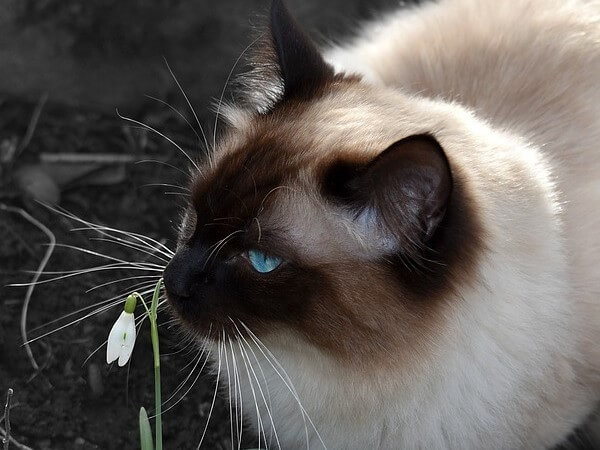
Chocolate Point Ragdoll, as the name suggests, belong to the Ragdoll family of cats. Experts categorize these felines based on patterns, coat markings, and shades, such as
- Bicolor coats.
- Colorpoint coats.
- Lynx coats.
- Mitted coats.
- Tortie coats.
Chocolate Points belong to the colorpoint coats category because of their unique coloring. They typically have ivory or cream-colored bodies with dark points of color near their extremities.
For example, they have chocolate-brownish fur on their face, ears, snouts, paws, and tails. These markings make them resemble Siamese cats quite a bit.
READ NEXT: Siamese Ragdoll Cat (Ragamese Complete Guide)
As kittens, Chocolate Point Ragdolls are generally white. Their color points appear a few hours after birth.
Experts state that these felines have darker extremities because of their circulatory functions. The lighter parts of their bodies have better blood flow. On the other hand, the extremities don’t get as much blood flow and mutate to a chocolate-brown shade.
Chocolate Ragdoll physical appearance
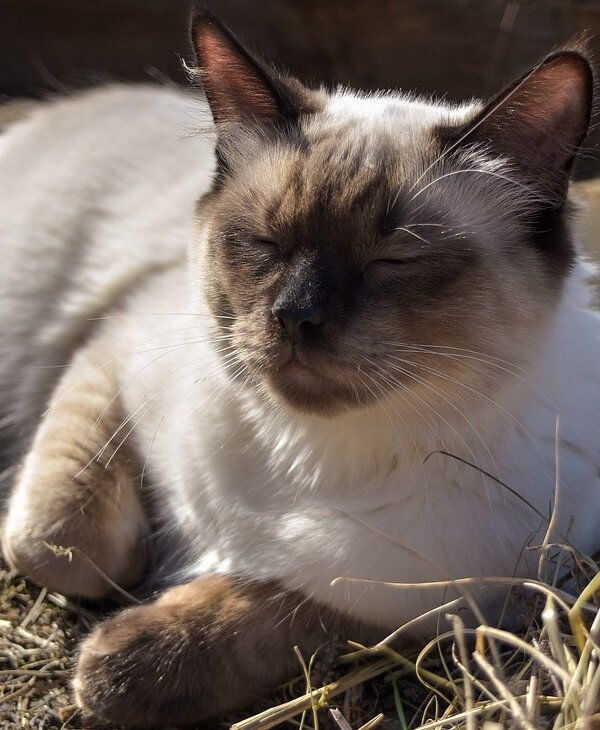
Ragdoll cats are available in around eight colors, and chocolate (or brown) is one of them. A Chocolate-colored Ragdoll can have one of three patterns: colorpoint, bicolor, and mitted. Although, some Chocolate Ragdolls can also have lynx or tortie variations.
Chocolate Ragdolls are long-bodied and pretty big in size. Adult males and females can weigh up to 15 to 20 pounds. They have semi-long and silky coats, along with plushy tails. The one thing all Ragdoll felines have in common is their oval-shaped blue eyes.
Chocolate Point Ragdoll genetics
Genetics plays an essential role in deciding a feline’s color and pattern. The same is true for Chocolate Point Ragdolls. The coat coloring of these cats is thanks to pigment molecules. The greater the concentration of pigments, the darker the cat’s color will be.
In regards to the colorpoint cats, these felines have pigment concentrated around the colder regions of their bodies. This makes the colorpoint gene pretty unique because it is thermosensitive.
Basic Ragdoll colors appear due to genes in combination with two possible alleles. These include ‘B’ (black) alternative to ‘b’ (brown), and ‘D’ (density) alternative to ‘d’ (dilution).
According to breeders, chocolate is recessive of the black allelic group (genotype bbDD (pure chocolate) or bbDd (chocolate-carrying dilute).
The coat color pattern, on the other hand, results from the recessive Siamese gene (cs). This is why breeders hoping to get a litter of pure Chocolate Points will need the chocolate coat pattern genome in both parents.
Feline owners should note that Ragdoll genetics are pretty complicated. If you want to improve the chances of breeding pure Chocolate Points Ragdolls, it’s best to contact breeding experts.
Is a Chocolate Point Ragdoll rare?
Yes, Chocolate Point Ragdolls are pretty rare. Feline lovers new to the Ragdoll world may find this a little strange at first. After all, brown isn’t too uncommon in cats.
However, when it comes to Chocolate Point Ragdoll Cat, their creamy bodies and warm brown points are a tricky combination to find. Both cat parents need to be pure Chocolate Point for the kittens to have the hallmark coloring.
People often mistake Seal Ragdolls for Chocolate Points, as the former is 30 percent more common. Thankfully, you can distinguish between the two because the point coloration of Seal Ragdoll is a darker and deeper brown compared to the warm chocolate brown of Chocolate Point Ragdolls.
Are Chocolate Ragdolls born brown?
No, Chocolate Ragdolls are not born brown. Actually, Chocolate Ragdoll kittens are completely white at birth. Their points may start to set in a few hours after birth.
Still, it can take days or weeks to be confident about their classic colorpoint markings.
By the eighth to tenth week mark, cat parents should know whether their kitten is a Chocolate Point Ragdoll or not.
Do all Chocolate Ragdolls have blue eyes?
Yes, all purebred Chocolate Ragdolls have oval-shaped blue eyes. The International Cat Association (TICA) states the same. Their vivid blue coloring is thanks to a particular gene found in the breed.
If you want to tell whether a Ragdoll is a pure breed or not, you don’t need to look further than his eyes.
Still, there are Ragdolls with green, yellow, or gold eyes. These generally belong to the Sepia, Mink, or Solid Color group of Ragdolls. They’re not, however, accepted as pure Ragdolls according to the breeding standards.
RECOMMENDED: Sepia Ragdoll (Complete Guide)
Is Chocolate a recognized Ragdoll Cat color?
Yes, Chocolate is a recognized color in the Ragdoll Cat community and it is one of the traditional Ragdoll breed colors. In addition to chocolate, The International Cat Association (TICA) also acknowledges the following colors for the Ragdoll breed:
- Cream Ragdoll.
- Flame Ragdoll.
- Lilac Ragdoll.
- Blue Ragdoll.
- Seal Ragdoll.
DON’T MISS: Blue Point Ragdoll (Complete Guide)
Various Chocolate Pointed Ragdoll colors and patterns
We’ve talked about colors and variations of the Ragdoll breed. But what other patterns and shades does the Chocolate Pointed Ragdoll come in? If you’ve been wondering the same, this next section is for you.
Chocolate Bicolor Ragdoll
A Chocolate Point bicolor Ragdoll will have white paws with light pink paw pads. These cats also have an upside V marking on their faces, which gives the appearance of a mask. Their belly, chest, and saddle area are generally white.
Chocolate mink Ragdoll
One of the biggest differences between a Chocolate mink cat and pure Ragdolls is that the former have greenish or greyish eyes. Besides that, it’s not easy to tell the two variations apart because of their similar coloring.
Experts suggest relying on coat texture for the Chocolate Point Mink Ragdoll. These have a much softer and silkier coat than regular Ragdolls.
When it comes to height and weight, the mink Chocolate Point Ragdoll is very much like the other variations of the breed.
Chocolate Lynx Ragdoll
A Chocolate lynx Point Ragdoll is typically ivory in color. Their body shading can include fur appearing darker at the tips or stripes that are lighter or darker than their color.
The Chocolate lynx Point variation also has milk chocolate points, especially around the ears.
The nose of a Chocolate Point lynx Ragdoll is tawny with or without pink edges. A Chocolate lynx Point Ragdoll kitten will be born white.
You may be interested in: White Ragdoll Cat (Complete Guide)
Chocolate mitted Ragdoll
A mitted Chocolate Point Ragdoll is nearly identical to a Chocolate Point Ragdoll in terms of coat coloring on their bodies. The word ‘mitt’ in Chocolate Point mitted Ragdoll is due to the white mitten-like appearance on their paws.
The Ragdoll Chocolate Point mitted variety also sports a white chin and may have white spots on their faces. They also have stripes on their bellies.
READ NEXT: Seal Mitted Ragdoll (Complete Guide)
Solid Chocolate Ragdoll
Solid Chocolate Ragdolls sport only choco-brown fur on their bodies. These felines can have green or sepia-toned eyes and their fur is super-soft and shiny.
Chocolate seal Point Ragdoll
You’ll notice a few differences if you see Chocolate seal Point Ragdoll kittens up close. This variation appears to have darker color points. They also have more dark fur on their faces, from their eyes to their muzzles and mouths.
Aside from that, the Ragdoll Chocolate seal Point displays pigment on its paws and tail. Their bodies are cream-colored.
Chocolate Point Ragdoll vs seal Point
The main difference between Chocolate Point Ragdoll and seal Point Ragdoll is that Chocolate Point Ragdoll is lighter while seal Point Ragdoll is much darker in color.
According to genetic experts, Seal Points have 56.25 percent of seal pigment. Chocolate Points have 75 percent of choco-brown coloring. In short, both varieties may look alike, but their colors differ widely.
Chocolate Tortie Ragdoll
The Chocolate Tortie Point Ragdoll has light chocolate color points with specks of cream or red. Their bodies are ivory, and their paw pads and noses can be tawny or rose-colored.
Can Chocolate Ragdolls change color?
Yes, Chocolate Ragdolls can change colors depending on their environment and body temperature. That’s because the point coloration gene in Ragdoll cats is thermosensitive.
That means the gene allows the cat’s fur to change color based on blood flow (or heat). That’s why Chocolate Ragdolls have darker fur at their extremities when their circulation, heat, and body temperature are low.
Do Chocolate Ragdolls change color when their body temperature is high?
Yes, Chocolate Ragdolls change color when their body temperature is high. Since the colorpoint gene reacts to thermal changes, these felines appear lighter when skin temperature rises. It’s why Chocolate Points have dark chocolate points when their body temperature is relatively cooler.
Do Chocolate Ragdolls change color when their body temperature is low?
Yes, Chocolate Ragdolls do change color when their body temperature is low. These cats have a distinct color gene that reacts to heat or circulation, making the areas with low circulation darker brown in color.
When these furry friends experience a drop in body temperature, their fur can darken temporarily. This change in hue is always exaggerated. And they revert to their actual color once the temperature reverts to normal.
However, if you notice your feline friends constantly have low body temperature, be sure to monitor them and observe them carefully. Constantly have low body temperature in cats is not normal. This could be a sign of health issues, both chronic and acute.
If you do notice your Chocolate Ragdolls are constantly having low body temperature, we highly recommend that you bring them to see a veterinarian to find out why they’re having low body temperature.
Do Chocolate Ragdolls get darker coats when they get older?
Yes, Chocolate Ragdolls do get darker coats when they get older. In fact, Chocolate Ragdolls are white at birth and gain color a week or two later. Once the kittens are ten weeks of age or more, you’ll definitely be able to see the Chocolate coat colors.
As the Chocolate Ragdolls get older, they start to get darker coats because their body temperatures decreases and their metabolism also slows down. When their body temperature is low, the body starts to produce more pigment. This is why their coat becomes darker around their face, limbs, and even their abdomen.
Additionally, you’ll also find that older Chocolate Ragdolls have dark coat colors on their bodies while their faces are white.
Experts also state that older cats may sometimes lose color due to deficiencies in their diet. For instance, excessive zinc intake can bring about color loss. Underlying health conditions, such as liver or thyroid defects, can also cause fluctuations in coat color.
Chocolate Ragdoll Cat size, height, and weight
If you’ve been wondering how big Chocolate Ragdolls can get when they mature, this section can offer some quick facts. Scroll below to learn the height and weight of male and female Chocolate Ragdoll Cats.
| Height | Weight | Length | |
| Male | 9-11 inches | 12-20 pounds | 18-21 inches |
| Female | 9-10 inches | 9-15 pounds | 17-19.5 inches |
Are overweight Chocolate Ragdolls darker in color than slim Chocolate Ragdolls?
Yes, overweight Chocolate Ragdolls are darker in color than slim Chocolate Ragdolls. That’s because fat tissues have low thermal conductivity and tend to redirect the heat away from the cat’s skin.
Therefore, since overweight Chocolate Ragdolls will have more fat, their colorpoints will likely change because of it. The coloration gene of Ragdolls is sensitive to body temperature. If there’s low body temperature in a specific area of the body, then that colder region of the body will have a higher concentration of pigment.
For instance, most fatty tissue deposit can be found on the chest and tummy and these are the areas with low body temperature. Since the fat deposits under the skin act as a shield and blocks the heat from the cat’s skin, you may find darker chocolate color tones around their tummy and chest where the fats are concentrated. .
Additionally, if you’re wondering why having more fat doesn’t make Ragdolls turn lighter, the answer is simple. Obese cats don’t move around a lot because of their weight. That means there’s not much activity to boost circulation and generate heat.
The good news is this type of color change is temporary. Once your feline sheds the excess weight, his skin will regulate thermal conductivity normally since there won’t be as much fatty tissue to block the heat from the skin. As a result, your Chocolate Ragdoll’s coat will lighten up a bit and isn’t too dark.
Chocolate Ragdoll Cats personality and temperament
Ragdolls are gentle giants of the feline world, and Chocolate Ragdolls are no different. These felines are incredibly peaceful, docile, and possess an even temperament. It’s rare to see a Chocolate Ragdoll hiss or swipe in anger.
In fact, Ragdolls are so relaxed that they go limp when picked up. That’s where the name ‘Ragdoll’ comes from. The breed also loves human company. They form deep bonds with their owners and follow their owners around like shadows.
Chocolate Ragdolls also do well around strangers. Their loving and tolerant personalities also make them great for families with children and other pets.
CHECK OUT: Are Ragdoll Cats Talkative Or Vocal?
Chocolate Point Ragdoll Cat training
Chocolate Ragdolls are highly intelligent apart from being affectionate. They’re excellent at observing humans and taking cues about their feelings too. All this makes Chocolate Ragdolls pretty easy to train.
Fortunately, kittens don’t require too much effort to become house-trained. However, you will need to potty train them. Once the litter is set up, allow the kitten to explore and sniff the contents. Allowing your kitten to visit the litter after every meal is also essential. It’s best to repeat this process a few times to ensure that your Chocolate Point Ragdoll kittens are successfully potty-trained.
Feline owners also have had success in teaching their Ragdolls tricks such as fetch. But all felines are different and each have their own individual nature.
That means some cats will learn and pick up tricks faster than others. Generally, teaching Chocolate Ragdolls tricks depends on perseverance and patience.
Ragdoll Chocolate Point exercise requirement
The optimal weight for Chocolate Ragdolls ranges between ten to twenty pounds. Felines are considered obese when they are ten percent over their body weight. Cat owners can ensure their Ragdolls stay in the best of health through high-quality cat food and regular exercise.
Chocolate Ragdolls need about 15 minutes of activity or playtime every day to stay fit and healthy. You can combine exercise, bonding and fun time to help your fuzzy friends burn calories and keep excess fat away.
Chocolate Point Ragdoll Cats grooming and cleaning
Chocolate Ragdolls have semi-long coats. Their luxurious and soft fur means they need a fair amount of grooming. While the breed isn’t as prone to matting as Persian cats, ignoring regular brushing can result in excessive shedding and hair lumps.
Since Chocolate Point Ragdoll Cats and Ragdolls in general like to groom themselves, large hair lumps can lead to choking. In some cases, when hair balls do enter the body, it can cause trichobezoar (gastrointestinal obstruction caused by hair balls) or blockage of the intestines which can lead to discomfort and abdominal pain and may require surgery.
If you’d like to know what a good grooming routine for the breed requires, check out our table below.
| Grooming Technique | Frequency |
| Hair Brushing | 2x a week for 10-15 minutes. |
| Bathing | Once every 4-6 weeks. |
| Nail Trimming | Every 2 weeks. |
| Teeth Brushing | 2-3x a week or give good-quality dental chew once a day. |
| Eye Care | Gently wipe once a day to remove crust. |
| Ear Care | Check weekly; wipe outer ears as required. |
Do Chocolate Point Ragdolls shed a lot?
Chocolate Point Ragdolls, like other Ragdoll cats, do shed. However, despite having thick, long hair, they are known to shed minimally.
Ragdolls (including Chocolate Ragdolls) generally shed less than many other cat breeds.
They typically shed the most during warmer seasons, particularly in spring and fall, as they lose their winter coat and prepare for warmer weather.
During the winter, they shed the least because their thicker coat helps them stay warm.
Other factors that affect their shedding include:
- Nutrition: A balanced diet with high-quality cat food helps maintain a healthy coat and reduces shedding.
- Grooming: Regular brushing removes loose hair and stimulates healthy hair growth, minimizing shedding.
- Health: Underlying health issues, like skin allergies or hormonal imbalances, can cause increased shedding.
- Stress: Cats can shed more when experiencing stress, so providing a stable and comfortable environment is essential.
Addressing these factors can help manage and reduce your Chocolate Point Ragdoll’s shedding.
Another way cat parents address the shedding is by investing in a powerful vacuum cleaner.
It is a good idea to get a vacuum cleaner that features a HEPA filter because it can remove 99.9% of the dander, hair, dust, and any particles from their home.
If you’re looking for a fur-free home, look no further than this vacuum cleaner. Designed with a powerful 1200-watt vortex motor, it quickly lifts pet hair, dander, and dust from hardwood floors, carpets, and furniture.
You’ll no longer need to struggle with stubborn fur or allergens.
With its 6-stage suction control, you can adjust the vacuum’s power for optimal performance on various surfaces, ensuring maximum efficiency.
The AirClean System, featuring a unique filter bag and exhaust filter, captures 99.9% of dust particles for cleaner air and a healthier environment for you and your feline friend.
Lightweight and equipped with a range of onboard accessories, this vacuum makes cleaning hard-to-reach areas like stairs, baseboards, and furniture a breeze. Its compact size and maneuverability make it an essential cleaning tool for any cat owner.
Invest in this vacuum cleaner today and enjoy a cleaner, fresher home tailored to your needs as a cat owner. Don’t wait – order now and experience the difference a premium cleaning solution can make for you and your beloved pet!
RELATED: Do Ragdoll Cats Shed? 7 Ways To Shed Less!
Are Chocolate Ragdoll Cats hypoallergenic?
No, Chocolate Ragdoll Cats are not hypoallergenic. Although some cat breeds are considered to produce fewer allergens than others, no cat breed is completely hypoallergenic.
Ragdoll cats produce the Fel d 1 protein, which is the primary allergen responsible for causing allergic reactions in sensitive individuals.
However, individual cats may produce varying levels of allergens, so it’s possible that some Ragdoll cats may cause fewer allergy symptoms than others.
If you’re a cat owner with pet allergies, investing in a high-quality air purifier can significantly improve your indoor air quality and minimize allergy symptoms.
Air purifiers with a HEPA filter can effectively trap pet dander, fur, dust, and other allergens. This helps to create a cleaner and more comfortable environment for you and your feline friend.
Don’t let allergies keep you from enjoying the company of your beloved cat. Invest in an air purifier today and breathe easier while sharing your home with your furry companion.
RECOMMENDED: Are Ragdoll Cats Hypoallergenic?
Chocolate Point Ragdoll food and diet
Felines are obligate carnivores and do their best on a meat-based diet. Owners looking to provide their kitty cats with the best of everything should invest in good-quality cat food. If you’re unsure about the ingredients or necessary nutrients, we highly recommend that ask your vet for a recommendation.
It’s important to note that when introducing a new food item or switching brands, make the change slowly and gradually. Sudden changes in diet can result in upset stomach and diarrhea.
Finally, your fluffy companion will appreciate a change in diet every now and then. You can break the monotony by giving your Chocolate Point Ragdoll nutritious treats as well.
Chocolate Pointed Ragdoll health issues
Chocolate Ragdolls are pretty robust and don’t suffer from too many health concerns. Nonetheless, the breed is susceptible to a few health issues. Below are some of the most common health culprits for Chocolate Ragdolls.
Whether you own a purebred (like the Ragdolls) or a mixed-breed cat, the cat DNA test kit is essential. This innovative test provides valuable insights into your cat’s genetic makeup, revealing breed-specific traits, predispositions to specific health conditions, and other critical information.
By understanding your cat’s unique genetic profile, you can make more informed decisions about their healthcare, nutrition, and exercise needs, ultimately improving their overall well-being.
Additionally, the test can help you discover and celebrate your cat’s unique ancestry, deepening the bond between you and your feline companion.
So, invest in a cat DNA test kit today and unlock the secrets hidden within your cat’s genes.
1. Gum Disease
Cats can develop dental concerns or gum disease due to poor oral hygiene. This typically occurs when food particles start collecting around the gums, leading to bad bacteria.
The microbes then cause inflammation along the gums and lead to tartar development.
If this is not treated early on, gum inflammation can progress to gingivitis. Over time, small gaps can form between your feline’s teeth and gums which causes bacteria pockets.
These microbes can then spread to other parts of the body and lead to kidney or liver problems. Gum disease can be avoided by relying on dry cat food as a staple, dental chews, and regular teeth cleanings at the vet.
2. Cardiomyopathy
Heart disease in felines can be congenital (present at birth) or acquired. While congenital problems can occur in Ragdolls, the real concern is Hypertrophic Cardiomyopathy. This disease causes the walls of the heart to thicken.
Over time, the heart’s efficiency is reduced, and your four-legged friends can experience heart failure. The condition isn’t curable, but early detection can help control disease progression.
3. Gastro Problems
Ragdolls are prone to problems affecting the gastrointestinal (GI) tract. These include obstructions and feline enteritis. Fortunately, most GI problems are curable and end in complete recovery.
4. Respiratory Tract Issues
Chocolate Ragdolls can suffer from cat flu, which affects the upper respiratory tract. They’re also prone to feline asthma, which involves the lower respiratory tract. Cat flu isn’t curable, but timely vaccinations can easily help to avoid it.
Alternatively, feline asthma can be controlled through injections, medications, or inhalers.
Chocolate Ragdoll lifespan
Chocolate Ragdolls become adults at the fourth year mark. They also have an average life expectancy of 14 to 15 years. However, Ragdolls lovers should note that lifespan statistics can vary depending on several factors including the feline’s overall health, lack of disease, exercise, and activity level to name a few.
The happier your Chocolate Ragdoll is, the more likely he is to reach or exceed his life expectancy. What is truly important is providing your little fur babies with the best quality of care.
Chocolate Ragdoll Cat breeders
Whether you’d like to get a Ragdoll cat or another cat breed, breeders can play a vital role. A breeder with an established reputation is much more likely to give you a purebred Chocolate Ragdoll.
Getting your kittens from a reputable breeder also means that the Ragdoll kittens have fewer chances of illnesses, thanks to proper breeding standards and code of ethics.
If you would like to bring home a Chocolate Ragdoll, it is essential to do thorough research and find out who the ethical and responsible breeders are in your area first.
Chocolate Ragdoll kittens
Many cat parents prefer to adopt their fluffy companions as kittens because they feel that a Chocolate Ragdoll kitten can easily adapt and adjust to new surroundings than a preowned feline. If you’re concerned about the right age to adopt Chocolate Point Ragdoll kittens, the answer is twelve weeks.
Kittens must stay with their mothers and siblings for as long as possible. This helps them learn essential behaviors. For example, a Chocolate Point Ragdoll kitten will from his mother cat skills like grooming, hunting, and burying waste.
Kittens also pick up socialization from each other. They understand how to differentiate between desirable and undesirable traits, like rough play. In short, it’s best to bring your Ragdoll Chocolate Point kitten home when he is at least three months old.
Chocolate Point Ragdoll price
A Chocolate Ragdoll can cost anywhere between $1,000 and $4,000, depending on its pedigree. If your kitten’s parents are show cats or award winners, you can expect to pay more.
With that said, it is possible for you to find Chocolate Point Ragdoll kittens for $800 as well.
However, these may not be actual Chocolate Point Ragdolls as the variation is rare. Most Chocolate Ragdolls end up turning out to be Seal Point Ragdolls. To avoid this, make sure you visit a renowned and reputable Ragdoll breeder.
Places to find Chocolate Ragdoll kittens for sale
There are plenty of trustworthy breeders and sellers out there if you’re searching for Chocolate Point Ragdoll kittens for sale. If you’re unsure of where to start looking, you can try out our recommendations below.
Ragdoll Kittens by Kelly (ragdollkittensbykelly.com/ragdoll-kittens-for-sale) is run by Karen Kelly. The cattery is based in California and has been in business since 2016. Besides having various types of Ragdolls, they also provide kittens that have been vaccinated and are house-trained and socialized from an early age.
If you’re located near the Pacific Northwest, you can turn to Riverside Rags (riversiderags.com/ragdoll-kittens-for-sale) to find your Chocolate Point kitten. The business has received the ‘cattery of excellence’ award from TICA and CFA. Additionally, their kittens are tested for various genetic health issues and come with a 10-year health guarantee.
Finding a healthy Chocolate Point Ragdoll for sale
If you’re a Ragdoll lover looking for adult Chocolate Point Ragdoll for sale, look no further than the reputable breeders below.
Based in Wisconsin, Starliterags (starliterags.net/available-kittens) has been breeding Ragdolls for over thirty years. They provide their cats with health guarantees and vaccination details. They ship all over the United States and are recognized by TICA.
Sunshine Ragdolls (sunshineragdolls.com) raise their felines in a cage-free environment. Their cats are well-versed in the art of socialization and come with genetic health guarantees to boot. This business is TICA certified and works out of New York City.
Chocolate Point Ragdoll: Pros and Cons
Are you still having trouble making up your mind about bringing home your very own Chocolate Ragdoll Cat? If so, we’ve made a pros and cons list for your quick consideration.
| Pros | Cons |
| Affectionate pet. | Can be quite expensive. |
| Constant companionship. | Requires regular grooming. |
| Low maintenance. | Not hypoallergenic. |
| Children friendly. | Prone to certain health problems. |
| Pet friendly. | Can’t be allowed outside. |
| Manageable expenses. | Can be loud (meowing). |
Is the Chocolate Pointed Ragdoll right for me?
Chocolate Pointed Ragdolls can make an ideal and affectionate fuzzy friend. They’re mild-tempered which makes them suitable for households with young children and existing pets.
However, one of the biggest drawbacks of the Chocolate Ragdoll Cats is that they’re rare, making them difficult to find. They’re also quite expensive, which means they may be pricey for those with a budget.
If you’re okay with the price range and want an affectionate and calm feline companion that is also pretty low maintenance, then a Chocolate Point Ragdoll is right for you.
Related Questions
The main difference between Chocolate Point and seal point Ragdoll is that Chocolate Point Ragdoll has much lighter shades of brown on his points while seal point Ragdoll has darker shades of brown on his points.
A Chocolate Point Ragdoll can cost as low as $800 and as high as $4,000. The price of a Chocolate Point Ragdoll depends on several factors including the breeder’s reputation and years of experience, and whether the parents of the kittens were show cats.
Some of the most unique Ragdolls are Lilac Ragdolls, Chocolate Ragdolls, Flames Ragdolls. These Ragdoll colors are pretty hard to find, but the rarest Ragdoll color is the Cream Ragdoll. These beauties have cream-colored bodies with white color points.
DISCLAIMER: THIS WEBSITE DOES NOT PROVIDE MEDICAL ADVICE
The information, including but not limited to, text, graphics, images and other material contained on this website are for informational purposes only. No material on this site is intended to be a substitute for professional veterinary advice, diagnosis, or treatment. Always seek the advice of your veterinarian or other qualified health care provider with any questions you may have regarding a medical condition.
Resources:
https://en.wikipedia.org/wiki/Ragdoll
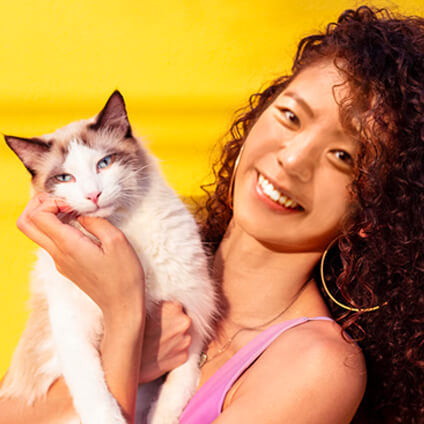
With over five years of specialized experience as an animal writer, my expertise lies in cat nutrition, health, behavior, grooming, and training. I am dedicated to delivering helpful and informative content that caters to the well-being of our feline friends. My primary goal is to empower pet owners with knowledge and ensure our feline companions thrive in health and happiness. In my free time, I love volunteering at local cat rescue centers.
